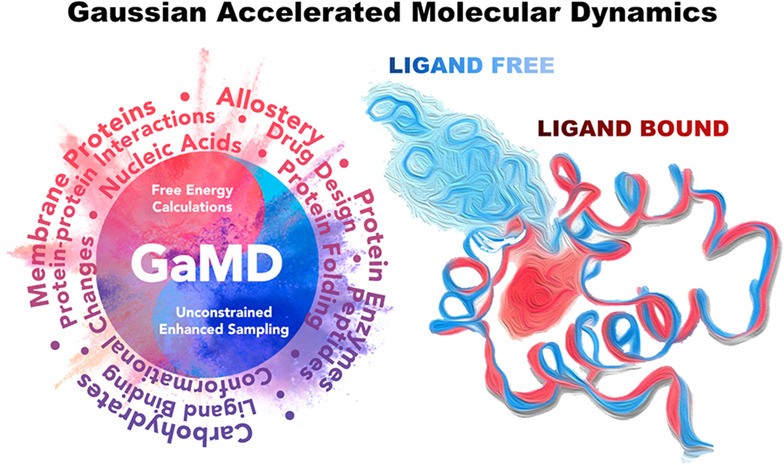GaMD
Gaussian accelerated molecular dynamics (GaMD)
Gaussian accelerated molecular dynamics (GaMD) is a robust computational method for simultaneous unconstrained enhanced sampling and free energy calculations of biomolecules. It works by adding a harmonic boost potential to smooth biomolecular potential energy surface and reduce energy barriers. GaMD greatly accelerates biomolecular simulations by orders of magnitude. Without the need to set predefined reaction coordinates or collective variables, GaMD provides unconstrained enhanced sampling and is advantageous for simulating complex biological processes. The GaMD boost potential exhibits a Gaussian distribution, thereby allowing for energetic reweighting via cumulant expansion to the second order (i.e., “Gaussian approximation”). This leads to accurate reconstruction of free energy landscapes of biomolecules. Hybrid schemes with other enhanced sampling methods, such as the replica exchange GaMD (rex-GaMD) and replica exchange umbrella sampling GaMD (GaREUS), have also been introduced, further improving sampling and free energy calculations. Recently, new “selective GaMD” algorithms including the ligand GaMD (LiGaMD) and peptide GaMD (Pep-GaMD) enabled microsecond simulations to capture repetitive dissociation and binding of small-molecule ligands and highly flexible peptides. The simulations then allowed highly efficient quantitative characterization of the ligand/peptide binding thermodynamics and kinetics. Taken together, GaMD and its innovative variants are applicable to simulate a wide variety of biomolecular dynamics, including protein folding, conformational changes and allostery, ligand binding, peptide binding, protein-protein/nucleic acid/carbohydrate interactions, and carbohydrate/nucleic acid interactions. In this review, we present principles of the GaMD algorithms and recent applications in biomolecular simulations and drug design.

References
Wang J, Arantes P, Bhattarai A, Hsu R, Pawnikar S, Huang Y-M, Palermo G* and Miao Y* (2021) Gaussian accelerated molecular dynamics: principles and applications. WIREs Computational Molecular Science: e1521. (Abstract | PDF)
• Advanced Science News: A “time-accelerated computational microscope” provides biologists with powerful insights
Pang, Y.T.#, Y. Miao#,*, Y. Wang* and J. A. McCammon* (2017) Gaussian accelerated molecular dynamics in NAMD, J Chemical Theory and Computation, 13(1): 9-19. (Abstract | PDF)
Miao, Y.*, Feher V. and McCammon JA (2015) Gaussian Accelerated Molecular Dynamics: Unconstrained Enhanced Sampling and Free Energy Calculation. J Chemical Theory and Computation, 11(8): 3584-3595. (Abstract | PDF)